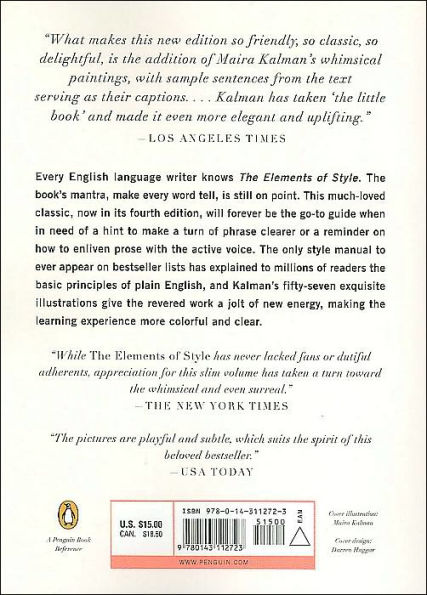Read an Excerpt
Chapter 2: Elementary Principles of Composition
12. Choose a suitable design and hold to it. A basic structural design underlies every kind of writing. Writers Will in part follow this design, in part deviate from it, according to their skills, their needs, and the unexpected events that accompany the act of composition. Writing, to be effective, must follow closely the thoughts of the writer, but not necessarily in the order in which those thoughts occur. This calls for a scheme of procedure. In some cases, the best design is no design, as with a love letter, which is simply an outpouring, or with a casual essay, which is a ramble. But in most cases, planning must be a deliberate prelude to writing. The first principle of composition, therefore, is to foresee or determine the shape of what is to come and pursue that shape.
A sonnet is built on a fourteen-line frame, each line containing five feet. Hence, sonneteers know exactly where they are headed, although they may not know how to get there. Most forms of composition are less clearly defined, more flexible, but all have skeletons to which the writer will bring the flesh and the blood. The more clearly the writer perceives the shape, the better are the chances of success.
13. Make the paragraph the unit of composition.
The paragraph is a convenient unit; it serves all forms of literary work. As long as it holds together, a paragraph may be of any length-a single, short sentence or a passage of great duration.
if the subject on which you are writing is of slight extent, or if you intend to treat it briefly, there may be no need to divide it into topics. Thus, a brief description, a brief book review, a brief account of a single incident, a narrative merely outlining an action, the setting forth of a single idea-any one of these is best written in a single paragraph. After the paragraph has been written, examine it to see whether division will improve it.
Ordinarily, however, a subject requires division into topics, each of which should be dealt with in a paragraph. The object of treating each topic in a paragraph by itself is, of course, to aid the reader. The beginning of each paragraph is a signal that a new step in the development of the subject has been reached.
As a rule, single sentences should not be written or printed as paragraphs. An exception may be made of sentences of transition, indicating the relation between the parts of an exposition or argument.
In dialogue, each speech, even if only a single word, is usually a paragraph by itself; that is, a new paragraph begins with each change of speaker. The application of this rule when dialogue and narrative are combined is best learned from examples in well-edited works of fiction. Sometimes a writer, seeking to create an effect of rapid talk or for some other reason, will elect not to set off each speech in a separate paragraph and instead will run speeches together. The common practice, however, and the one that serves best in most instances, is to give each speech a paragraph of its own.
As a rule, begin each paragraph either with a sentence that suggests the topic or with a sentence that helps the transition. If a paragraph forms part of a larger composition, its relation to what precedes, or its function as a part of the whole, may need to be expressed. This can sometimes be done by a mere word or phrase (again, therefore, for the same reason) in the first sentence. Sometimes, however, it is expedient to get into the topic slowly, by way of a sentence or two of introduction or transition.
In narration and description, the paragraph sometimes begins with a concise, comprehensive statement serving to hold together the details that follow.
The breeze served us admirably. The campaign opened with a series of reverses.
The next ten or twelve pages were filled with a curious set of entries.
But when this device, or any device, is too often used, it becomes a mannerism. More commonly, the opening sentence simply indicates by its subject the direction the paragraph is to take.
At length I thought I might return toward the stockade. He picked up the heavy lamp from the table and began to explore.
Another flight of steps, and they emerged on the roof.
In animated narrative, the paragraphs are likely to be short and without any semblance of a topic sentence, the writer rushing headlong, event following event in rapid succession. The break between such paragraphs merely serves the purpose of a rhetorical pause, throwing into prominence some detail of the action.
In general, remember that paragraphing calls for a good eye as well as a logical mind. Enormous blocks of print look formidable to readers, who are often reluctant to tackle them. Therefore, breaking long paragraphs in two, even if it is not necessary to do so for sense, meaning, or logical development, is often a visual help. But remember, too, that firing off many short paragraphs in quick succession can be distracting. Paragraph breaks used only for show read like the writing of commerce or of display advertising. Moderation and a sense of order should be the main considerations in paragraphing....











